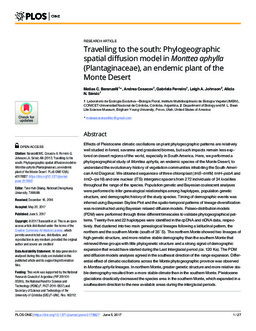| dc.contributor.author | Baranzelli, Matias Cristian | |
| dc.contributor.author | Cosacov, Andrea | |
| dc.contributor.author | Ferreiro, Gabriela | |
| dc.contributor.author | Johnson, Leight A. | |
| dc.contributor.author | Sérsic, Alicia N. | |
| dc.date.accessioned | 2021-04-27T22:06:44Z | |
| dc.date.available | 2021-04-27T22:06:44Z | |
| dc.date.issued | 2017-05 | |
| dc.identifier.citation | Travelling to the south: Phylogeographic spatial diffusion model in Monttea aphylla (Plantaginaceae), an endemic plant of the Monte Desert Baranzelli MC, Cosacov A, Ferreiro G, Johnson LA, Sérsic AN (2017) Travelling to the south: Phylogeographic spatial diffusion model in Monttea aphylla (Plantaginaceae), an endemic plant of the Monte Desert. PLOS ONE 12(6): e0178827. https://doi.org/10.1371/journal.pone.0178827 | es |
| dc.identifier.other | doi.org/10.1371/journal.pone.0178827 | |
| dc.identifier.uri | http://hdl.handle.net/11086/18112 | |
| dc.description.abstract | Effects of Pleistocene climatic oscillations on plant phylogeographic patterns are relatively well studied in forest, savanna and grassland biomes, but such impacts remain less explored on desert regions of the world, especially in South America. Here, we performed a phylogeographical study of Monttea aphylla, an endemic species of the Monte Desert, to understand the evolutionary history of vegetation communities inhabiting the South American Arid Diagonal. We obtained sequences of three chloroplast (trnS–trnfM, trnH–psbA and trnQ–rps16) and one nuclear (ITS) intergenic spacers from 272 individuals of 34 localities throughout the range of the species. Population genetic and Bayesian coalescent analyses were performed to infer genealogical relationships among haplotypes, population genetic structure, and demographic history of the study species. Timing of demographic events was inferred using Bayesian Skyline Plot and the spatio-temporal patterns of lineage diversification was reconstructed using Bayesian relaxed diffusion models. Palaeo-distribution models (PDM) were performed through three different timescales to validate phylogeographical patterns. Twenty-five and 22 haplotypes were identified in the cpDNA and nDNA data, respectively. that clustered into two main genealogical lineages following a latitudinal pattern, the northern and the southern Monte (south of 35° S). The northern Monte showed two lineages of high genetic structure, and more relative stable demography than the southern Monte that retrieved three groups with little phylogenetic structure and a strong signal of demographic expansion that would have started during the Last Interglacial period (ca. 120 Ka). The PDM and diffusion models analyses agreed in the southeast direction of the range expansion. Differential effect of climatic oscillations across the Monte phytogeographic province was observed in Monttea aphylla lineages. In northern Monte, greater genetic structure and more relative stable demography resulted from a more stable climate than in the southern Monte. Pleistocene glaciations drastically decreased the species area in the southern Monte, which expanded in a southeastern direction to the new available areas during the interglacial periods. | es |
| dc.language.iso | eng | es |
| dc.relation | info:eu-repo/semantics/reference/hdl/11086/18102 | |
| dc.rights | Atribución-NoComercial-CompartirIgual 4.0 Internacional | * |
| dc.rights.uri | http://creativecommons.org/licenses/by-nc-sa/4.0/ | * |
| dc.subject | Ciencias biologicas | |
| dc.subject | Monttea aphylla | |
| dc.subject | South American | |
| dc.subject | Variaciones Climaticas | |
| dc.subject | Pleistoceno | |
| dc.subject | patrones filogeográficos | |
| dc.subject | climatic oscillations | |
| dc.subject | phylogeographic patterns | |
| dc.subject | Pleistocene | |
| dc.title | Travelling to the south: Phylogeographic spatial diffusion model in Monttea aphylla (Plantaginaceae), an endemic plant of the Monte Desert | es |
| dc.type | article | es |
| dc.description.version | publishedVersion | es |
| dc.description.fil | Baranzelli, Matías Cristian. Universidad Nacional de Córdoba. Facultad de Ciencias Exactas, Físicas y Naturales; Argentina. | es |
| dc.description.fil | Baranzelli, Matías Cristian. Consejo Nacional de Investigaciones Científicas y Técnicas. Instituto de Investigaciones Biológicas y Tecnológicas; Argentina. | es |
| dc.description.fil | Cosacov, Andrea. Universidad Nacional de Córdoba. Facultad de Ciencias Exactas, Físicas y Naturales; Argentina. | es |
| dc.description.fil | Cosacov, Andrea. Consejo Nacional de Investigaciones Científicas y Técnicas. Instituto de Investigaciones Biológicas; Argentina | es |
| dc.description.fil | Ferreiro, Gabriela. Universidad Nacional de Córdoba. Facultad de Ciencias Exactas, Físicas y Naturales; Argentin | es |
| dc.description.fil | Ferreiro, Gabriela. Consejo Nacional de Investigaciones Científicas y Técnicas. Instituto de Investigaciones Biológicas y Tecnológicas; Argentina | es |
| dc.description.fil | Johnson, Leight a. Brigham Young University. Department of Biology and S.L. Welsh Herbarium; USA. | es |
| dc.description.fil | Sérsic, Alicia N. Universidad Nacional de Córdoba. Facultad de Ciencias Exactas, Físicas y Naturales; Argentina. | es |
| dc.description.fil | Sérsic, Alicia N. Consejo Nacional de Investigaciones Científicas y Técnicas. Instituto de Investigaciones Biológicas y Tecnológicas; Argentina | es |
| dc.journal.country | Estados Unidos | es |
| dc.journal.editorial | Public Library of Science | es |
| dc.journal.number | 12 | es |
| dc.journal.title | PLoS ONE | es |
| dc.journal.volume | 6 | es |





